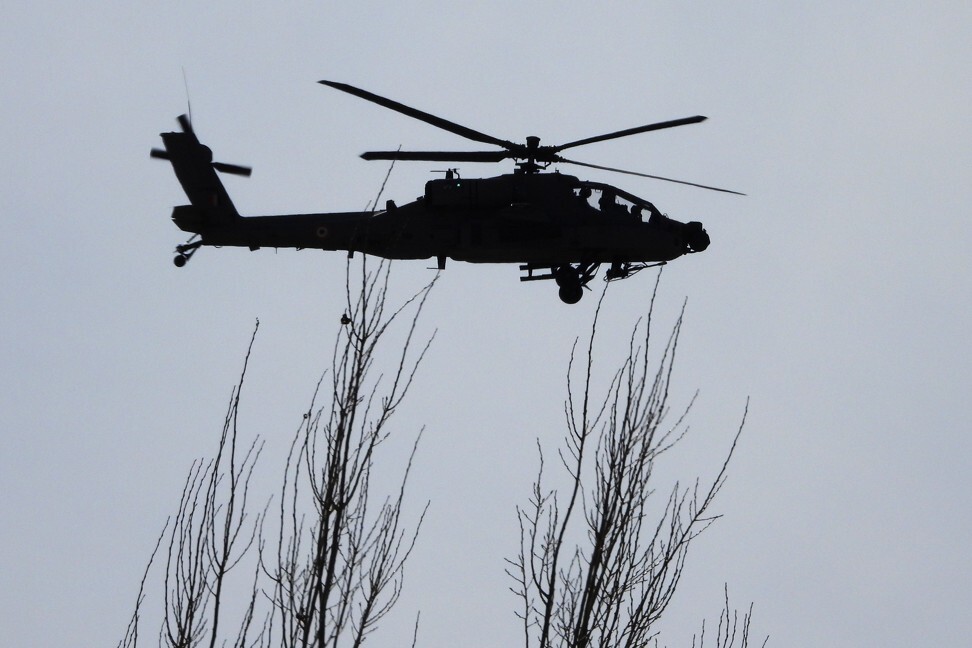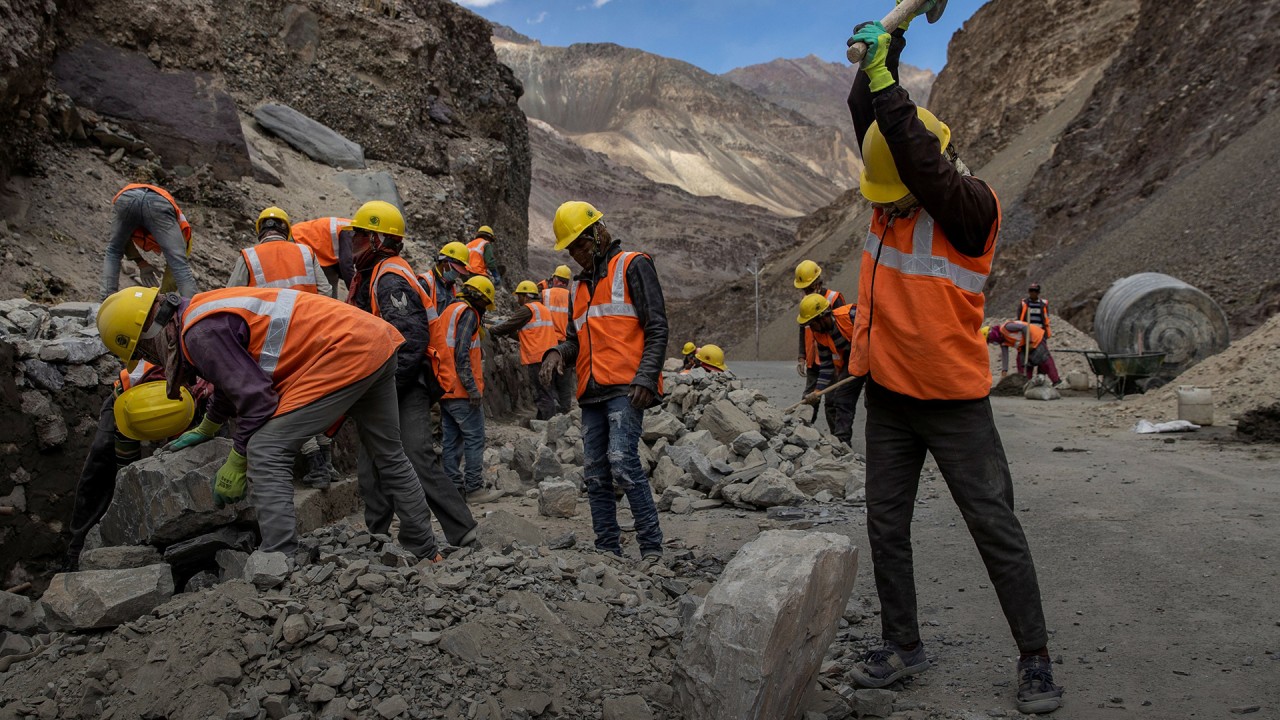
China and India dig in at Himalayan border, with an eye on Washington
- There is no resolution in sight in the months-long border stand-off, with both countries’ militaries reinforcing their positions and no talks scheduled
- Analysts say Beijing is trying to get a better feel for what US President-elect Joe Biden’s China policy might be before making its next move
Talks between the two countries have all but been derailed since military officials last met two months ago – the longest gap in such negotiations since May – with both sides reinforcing their positions and digging their heels in.
Unverified images that have surfaced on Chinese social media recently show Indian and Chinese tanks and other armoured vehicles lined up in a face-off metres away from each other.
Chinese troops have already moved forward in strategically sensitive areas like Depsang, so they don’t need to do anything now
On Monday, Indian Army chief M.M. Naravane spelt out India’s position on the stand-off, saying at a press conference that his country was “ready for the long haul” and that its troops were prepared to “hold our ground as long as it takes”.
In the last two days, India’s chief of defence staff, General Bipin Rawat, and air force chief, R.K.S. Bhaduria, have visited forward areas along the Line of Actual Control (LAC), the unmarked, de facto border separating Ladakh from the Chinese-controlled Aksai Chin region. Around the same time, online videos have surfaced of Chinese troops conducting drills in the area.
Intelligence analysts later identified the area to be just 36km (22 miles) away from the Indian region of Depsang in northern Ladakh.
With tensions rising and talks unlikely any time soon, the stand-off is likely to continue through the harsh winter that engulfs the Himalayan region of Ladakh until April, with temperatures dropping to minus 40 degrees Celsius (minus 40 degrees Fahrenheit).

The stand-off dates to last May, after troops from both sides clashed on the banks of Pangong Lake. The skirmish led to a military face-off at a number of points along the LAC. The two countries share a 3,488-kilometre (2,167-mile) land border, much of it undemarcated and often the cause of disputes between the two, including a full-blown military war in 1962.
Since the stand-off began, tensions have only mounted. Soldiers clashed in the Galwan river valley, north of Pangong Lake, on June 15, resulting in the deaths of at least 20 Indian soldiers and an undisclosed number of Chinese troops.
In November, Indian media said the two sides were in the final stages of an agreement to disengage troops, but the Chinese were quick to deny the reports. Since November 6, there has been no contact between the two sides’ military commanders.
China faces battle of wits in Nepal as US backs Tibetans, India dangles jabs
Analysts in New Delhi believe the current pause in talks might be a strategic manoeuvre by Beijing as it casts an eye on Washington to get a better sense of what US President-elect Joe Biden’s policy toward China will entail.
“If Biden’s policy towards China is going to be as tough as Trump’s China policy and if China perceives a higher level of threat from the US, then it is unlikely to want to open up another front with India,” said retired Indian Navy commodore C. Uday Bhaskar, the current director of the Society for Policy Studies, a New Delhi think tank.

03:06
India pushes to build roads near Chinese border, in a bid to boost infrastructure in border areas
Two recent events may be shaping Beijing’s considerations of US policy. Last week, the outgoing US ambassador to India, Kenneth Juster, disclosed that the two countries had been working “in close coordination” through the border stand-off, to help India counter what he said was “sustained … aggressive Chinese activity on its border”.
Indian media reports have said that New Delhi was relying on Washington for satellite imagery as well as emergency purchases of cold-weather equipment for its personnel in the Himalayas.
On Monday, a 2018 US document on its Indo-Pacific strategy was declassified, laying bare Washington’s view that India was “pre-eminent in South Asia” and that a “strong India” would “act as counterbalance to China”.
It added that in light of strengthened US-India ties, the US should act to “accelerate India’s rise and capacity to serve as a net provider of security and Major Defence Partner”.
The warmth between its two rivals has not gone down well with China. Responding to Juster’s remarks, China’s ambassador to India, Sun Weidong, tweeted, “We firmly oppose any third party meddling in China-India border issue and hope US relations with others not target any specific country.”
Bhaskar, the retired Indian Navy commodore, said Beijing might now be wary about any escalation in tensions with New Delhi.
“China wants to project itself as a status quo power, not wanting to rock any boats, and a power that is willing to negotiate and have normal relations with other countries,” he said. “Challenging India militarily might not be the best card to play right now.”
But others said the current stalemate between China and India might have tactical benefits for both countries.
Deepak Sinha, a retired Indian Army brigadier who has had extensive experience carrying out counter-insurgency and airborne special operations in India’s northeast region, said the stalemate could benefit Beijing in the long term.
China-India stand-off: amid push for fresh talks, a winter of uncertainty
Pointing to reports of People’s Liberation Army exercises in a region close to Depsang, Sinha said the proximity of Chinese troops to sensitive Indian positions did not “bode well” for New Delhi.
“Chinese troops have already moved forward in strategically sensitive areas like Depsang, so they don’t need to do anything now,” Sinha said. “Instead, they could choose their opportunity maybe even in two or three years to mount a military challenge to India in these areas.”

03:23
China mocks the US as Beijing compares chaos at Capitol with Hong Kong protests
Manoj Joshi, a distinguished fellow at the New Delhi think tank Observer Research Foundation, said that China “may not want a resolution” to the stand-off any time soon because of the cost to New Delhi.
“China has locked India into an expensive and a long-term deployment, which is very expensive,” Joshi said, adding that such a stand-off also forces India to focus much more on land rather than on maritime security and the Indian Ocean, a situation that benefits Beijing.
But some analysts have argued that the stand-off could prove to be beneficial for India’s image, especially among other smaller Asian nations.
Writing in Hindustan Times, Harsh Pant, a professor of international relations at King’s College in London, said: “By standing up militarily to China on the Himalayan borders, India also made it possible for smaller nations at the receiving end of Chinese aggression to envision the possibility that subservience to China is not the only option.”
But for now, foreign-policy analysts in New Delhi believe India is unlikely to make any aggressive manoeuvres. Instead, as Bhaskar pointed out, its recent act of returning a Chinese soldier captured on the Indian side of the LAC at Chushul came with a message for Beijing.
“I think India wants to convey that it does not want to aggravate things any further, even if it has the opportunities to,” he said.

